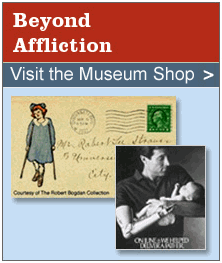Education: Overview
Disability History in the Classroom
DHM Education integrates disability history with larger themes commonly addressed in secondary and higher education U.S. History, American Studies, Civics, Government, and Law courses. Lessons are designed to stand alone but also cluster around central topics, with each approaching their subject from different perspectives. All the lessons use primary sources, background essays, provide pedagogical objectives, and include a study guide. Seven lessons associated with two clusters are currently available. We welcome feedback and invite you to use the Evaluate tools and Standards feature.
The language associated with disability over decades and centuries is quite fluid and at times inflammatory and demeaning. Our essay "On Language and History: Who Is Speaking?" will help newcomers to the field orient themselves to these issues. For faculty wondering why and how to use disability as a topic of historical analysis like gender, race, or class, we recommend Dr. Douglas Baynton's essay, "Disability and the Justification of Inequality in American History."
Feature Highlight
DISABILITY AND MORAL REFORM: 1820-1860
"Hearing Voices" and The Campaign for Moral Treatment

When President Franklin Pierce vetoed the bill Dorothea Dix had successfully shepherded through Congress, his state's rights argument influenced U.S. social welfare policy for the next eight decades. These lessons take up her work, and also present accounts by several asylum residents. The lessons study the issues from profoundly different perspectives. Despite the age of the primary sources, many of the issues they address will be uncannily familiar to contemporary audiences. More
Educating The Senses:
The 19th Century Awakes to Reform
According to the US Census of 2006, over six million students, 13.6% of the children in K-12 classrooms in the US have a disability that requires an Individualized Education Plan. What we now call special education began with the establishment of the first residential schools for blind and deaf children and adults and the techniques they developed to promote literacy. These lessons consider how the Three R's were achieved in the antebellum period for able and disabled students alike, and how they were thought an essential skill to help preserve the virtue of a new nation's citizens. More







